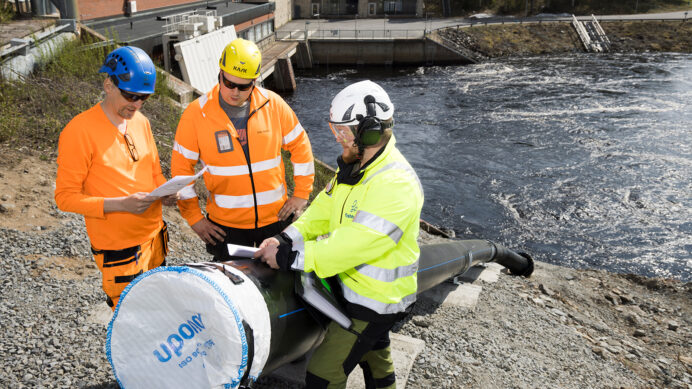
Installation work for the Kalasydän fishway has started at the Pohjolan Voima power plant in Raasakka, located on the Iijoki river. The new fishway is planned for deployment in June, after the spring floods. The new solution is part of our work in restoring migratory fish stocks, and it also provides us with valuable data for our future projects.
The Kalasydän fishway allows fish to travel upstream past our Raasakka power plant. Additionally, the fishway boosts the crossing of salmon and trout in a fish-friendly manner, without human intervention. The system can also be used in the procurement of Baltic whitefish roe and to support the crossing of lampreys.
“At the moment, the pipelines for the Kalasydän fishway are being run from the basin below the power plant into the reservoir. We have already performed earthwork in the land areas surrounding the plant. All the permanent structures of the fishway will be built on solid ground. The actual Kalasydän device will be placed in the basin below the power plant” says environmental expert Jyrki Salo from PVO-Vesivoima.
The Kalasydän fishway developed by Kalasydän Oy will be deployed for the summer season, which last right up to October, and the floating device will then be lifted out of the water and decommissioned for the winter. In the system, fish are hydraulically directed through a network of pipes either past the power plant and into the reservoir, or into a container, in which they will be transported upstream of Iijoki river’s top-most power plant, the Haapakoski plant. With the help of AI, the system monitors the numbers and species of the fish passing through it in real time.
New data collected on the Kalasydän fishway as part of migratory fish restoration work
At the Raasakka plant, the full-scale hydraulic Kalasydän fishway is now being employed for the first time at the lowest point along the Iijoki river, where migratory fish arrive directly from the sea. This will be key in shedding light on the functionality of the solution. The plan in Raasakka is also to implement studies of the numbers of migratory fish arriving at the power plant and on the efficiency of the Kalasydän solution.
“The Kalasydän fishway will be deployed in Raasakka over 2023–2025. Based on the results, the fishway may become a permanent solution together with other migration route solutions at the Raasakka power plant, or we can relocate it to a different site. Kalasydän does not replace any other planned fishway projects. The active monitoring included the Kalasydän solution allows us to assess and improve both the efficiency of the system itself and the joint functionality of various different migratory fish solutions both now and in the future,” Jyrki Salo says.
As part of an extensive collaboration project, we have implemented Finland’s first downstream migration route at the Haapakoski plant at the top of the Iijoki river, allowing young salmonids travelling downstream access past the power plant.
Additional information:
Jyrki Salo, environmental specialist, PVO-Vesivoima Oy, tel. +358 50 3058 299, jyrki.salo@pvo.fi
PVO-Vesivoima Oy produces electricity with its hydropower plants on the Iijoki, Kemijoki and Kokemäenjoki rivers. The average total annual energy production output of the company is 1.7 TWh. The company is part of the Pohjolan Voima Group. www.pohjolanvoima.fi; Twitter: @PVOVesivoima